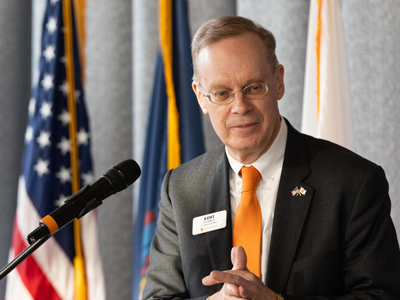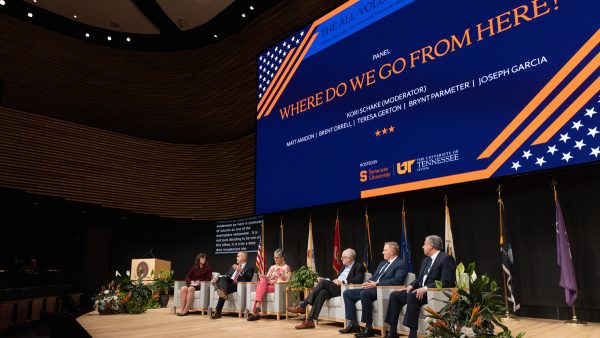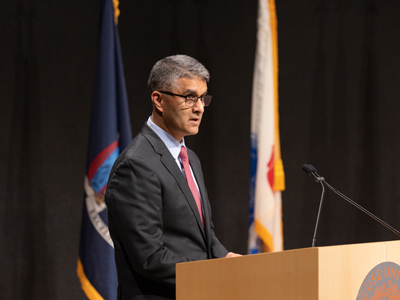Institutions of higher education like Syracuse University and the country’s military are both facing an approaching demographic cliff due in part to declining birth rates stemming from the 2008 economic recession.
With both sectors preparing for significant recruitment and enrollment challenges, Syracuse University and the University of Tennessee co-hosted a first-of-its-kind, two-day summit to explore how higher education and the federal government could partner up to better support our nation’s service members.

Held during the 50th anniversary of the end of the military draft and the birth of America’s all-volunteer force, “The All-Volunteer Force at 50: Higher Education and America’s Volunteer Military” summit saw more than two dozen university chancellors and presidents from across the country meet with senior government officials in the Department of Defense (DoD) and Department of Veterans Affairs (VA) to address some of the most pressing challenges facing veterans and the long-term sustainability of an all-volunteer armed services.
“We can work together for the common good, and that’s special. We need to create clear pathways to opportunities for enlisted persons, and we need to tell their stories if we expect our enlisted service system to continue working. The pathways need to include much less siloed cooperation, moving back and forth between jobs, academia and the military to create those pathways,” Chancellor Kent Syverud told the summit attendees during his closing remarks.

Seven Key Takeaways
Kori Schake, senior fellow and director of foreign and defense policy with the American Enterprise Institute, moderated the panel discussion “Where Do We Go From Here?” and summarized the key takeaways as the following:
- Understanding the difference between being veteran friendly (think social media posts touting the benefits of attending a university) and veteran ready (providing the resources, support and access to education that sets members of the military-connected community up for success).
- Improving higher education’s access to the DoD, including nearby military bases.
- Understanding how to navigate DoD bureaucracy, including communicating with military-connected individuals to ensure they understand the process and costs of earning a degree.
- Establishing VA pilot programs to see what’s working for veterans, and what support they need to succeed.
- Creating community for all veterans on campus.
- Reimagining education, military service and work as an ecosystem of exchange, including what the lifecycle in that ecosystem looks like for service members.
- Conveying student veteran best practices to the DoD and VA.
“How can we think differently about our relationship, and maybe explore opportunities to collaborate and partner moving forward? One of the drivers of volunteerism for military service today is service as a pathway to education. How can we make access to higher education easier, more accessible, more affordable, and by doing so, create more of a push to national service?” said Vice Chancellor for Strategic Initiatives and Innovation J. Michael Haynie, founder and executive director of the D’Aniello Institute for Veterans and Military Families (IVMF).

An Obligation to Make Sure Veterans Reach Their Full Potential
Summit participants agreed that changes need to come, and soon, including altering the narrative around veterans who serve. Matt Amidon, senior advisor with the George W. Bush Institute, said young people view veterans as either heroes who deserve to be lauded or victims to feel sorry for, thanks to their depiction in films and television shows, instead of valued community members who just want to focus on their goals as civilians once they transition out of active duty.
Also, instead of viewing veterans as outsiders in society, University of Montana President Seth Bodnar, a U.S. Army veteran, pointed to the use of compelling storytelling to help spotlight how military-connected students can enhance a college campus.
“Let’s not ‘otherize’ our veterans by acting like they’re not part of our society. I get that military service is so concentrated, but our veterans are not a separate part of our society; they are an integral part, and we have an obligation to make sure every member of our veteran community can reach their unique, full potential,” Bodnar said during the panel, “Competition vs. Collaboration: Common Challenges Make Us Better Together.”
A different mentality is needed too, when it comes to recruiting the next class of veterans to higher education.
“Instead of competing, maybe we can think about innovative ways to collaborate and to partner to the betterment of both institutions,” said Haynie.
Eliminating Barriers to Higher Education
Each year, more than 200,000 military members make the transition from active duty to civilian life, with 74% of that population pursuing a higher education degree once their service has ended.
But only 60% of veterans take advantage of their post-9/11 GI Bill benefits, while 19% of veterans won’t use their benefits because they think it’s too difficult to navigate through higher education or they don’t have enough knowledge about their benefits.
“How can everyone who has served and earned that right, which they’re entitled to, take advantage of their benefits? This is part of paying and rewarding those who made the sacrifice with their hard-earned benefits,” said Joseph Garcia, executive director of education service in the Department of Veterans Affairs.
There are currently 2.3 million active and reserve service members in the U.S., and 75% of enlistees come from military legacy families, meaning their decision to serve was inspired by someone they know who had a history of service, said Ashish S. Vazirani, the DoD’s deputy undersecretary of defense for personnel and readiness who delivered the keynote address.
“Younger Americans are not exposed to the unique and compelling stories of service and the pathways to education offered by service. The military embraces most of the values these young people seek in life and in a career,” Vazirani said.
“We’re Going to Work Forward, Together”
As the summit drew to a close, there was a sense of optimism that the core principles addressed during the two-day gathering would lead to momentum and sustained change moving forward.

“I’ve been to Syracuse University three times before [to discuss this topic] and up until this visit, the conversation was always linear and one-way,” said Brent Orrell, senior fellow with the American Enterprise Institute. “But today we had productive conversations that were not linear but an ecosphere of exchanges between the institutions. Each of these institutions are working to progress toward the same ends of creating a stronger America.”
“This summit was never intended to be a one and done. It was intended to be a call to action on a critical problem facing our military and our country. We’re going to work forward, together,” added Chancellor Syverud.
